Staring at the odd-looking bumps under your skin? You may be suffering from Sebaceous or Epidermal cysts, a medical condition that gives an abnormal appearance to your skin.
What is a Sebaceous Cyst?
Page Contents
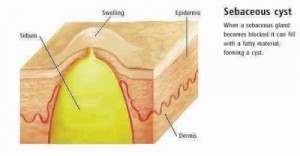
Picture 1 – Sebaceous Cyst
Source – photobucket
Sebaceous Cysts, sometimes misspelled as Sebacous Cysts, are firm, dome-shaped sacs or lumps appearing beneath the skin. These sacs are filled with a white oily substance known as the keratin, the fibrous protein found in hairs and nails which often emit a foul odor. The bumps are found in many areas of the body like the face, scalp, chest, neck, ears, upper back and even private parts like the genitals.
The condition affects about 200000 people in the United States alone.
Causes of Sebaceous Cysts
Sebaceous or Epidermal cysts are formed due to a number of factors. These include :
Swollen Hair Follicles
When hair follicles suffer an inflammation due to acne or some other cause, it may lead to the accumulation of keratin compounds under the skin.
Skin Injury or Trauma
When the skin suffers an injury, the affected cells block hair follicles located deep inside the skin. The epidermis is implanted into the dermis and results in an inflammation that is visible in the form of Sebaceous Cysts.
Impaired Sebaceous Gland
When the Sebaceous gland, the gland near the hair follicles, fails to perform normally due to a defect or blockage the keratin may accumulate in a particular spot and form a lump.
Bacterial Infection
In some cases, cysts may be formed in skin areas affected by bacteria.
Symptoms of Epidermal Cyst
Epidermal Cysts are accompanied with several symptoms, most of which are visible to the naked eye. These include :
Lumps
Small lumps or sacs formed on the skin are the most visible symptoms of this condition. These are the Sebaceous Cysts, also known as Epidermoid Cysts.
Tenderness
The Sebaceous Cysts are generally non-painful. However, patients with an infected cyst can experience a feeling of tenderness in the affected region.
Drainage
In some cases, a foul-smelling grayish white substance may drain from the cyst.
Redness
If the cysts swell, there may be redness in the area.
Hotness
Sufferers may also feel an increase in temperature in the affected region of the skin.
Movable
In many cases, the cysts are freely movable beneath the skin.
Diagnosis of Sebaceous Cysts
Doctors mostly diagnose Sebaceous Cysts by judging their appearance. The medical history of the patient is also often taken into consideration. The sufferer is asked about the symptoms to make a proper diagnosis. Physical tests are also conducted to ascertain the reason behind the condition. Occasionally, a biopsy is needed to prevent misdiagnosis and make sure that the cysts have not developed due to any other skin condition.
Sebaceous Cyst Treatment
Sebaceous Cysts treatment includes home remedies as well as professional medical care.
Treatment for Sebaceous Cyst (Medication and Removal)
Painless Epidermal cysts are normally harmless and need no treatment. These appear and normally go away after a few days. But if the cysts get infected they may swell to be large enough or drain from time to time. The bumps may become a cause for embarrassment in such cases and require medical attention. You should ideally visit a dermatologist, a doctor who specializes in treating skin problems.
Doctors normally use steroid medications such as corticosteroid injections to reduce the pain and swelling in the cysts.
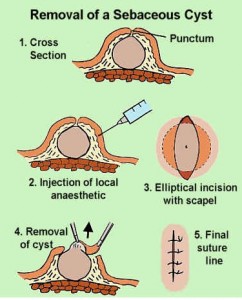
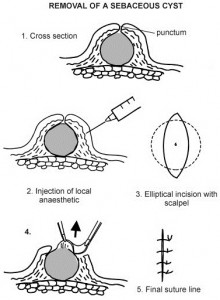
Picture 2 – Sebaceous Cyst Removal Picture 3 – Sebaceous Cyst Surgery
Source – moondragon Source – patient.co.uk
An oral antibiotic may be prescribed in case of an infected cyst. This reduces the chances of an infection after drainage or surgical removal of the cysts.
Cysts draining from time to time need surgical drainage. This involves cutting the cyst open by surgical means, draining its contents and removing the upper wall. This may give temporary relief but the cyst will eventually come back. This is the only disadvantage of this procedure.
If the cyst becomes too large or swollen, Epidermal Cyst removal may be the only option. Complete removal of Sebaceous Cysts is done to prevent their recurrence. Cysts that go by themselves also have a chance of coming back. Sebaceous Cyst removal is done by a small surgical operation done performed in the doctor’s chamber.
Sebaceous Cyst Treatment (Home or Natural)
Want to know how to get rid of Sebaceous Cyst at home? Most people with painless Sebaceous Cysts are looking for Sebaceous Cyst remedy at home. Here are some ways you can treat Sebaceous Cysts by yourself.
Applying a warm, moist cloth over the cysts for a few types during the day can make them subside after a period of time.
If a cyst drains at home, you should carefully expose the area and wash it with cotton moistened with antiseptic. This will prevent bacterial infection till you see a doctor. You should not try to open or remove a Sebacous Cyst by yourself. This can lead to an infection that will bring on more severe complications.
Prevention of Epidermal Cysts
Unfortunately, there is no way to prevent the occurrence of Sebaceous Cysts. The cysts are actually diagnosed after a person notices their presence in the skin and informs a doctor about it. As aforementioned, cysts may come back even after surgical drainage. This is especially true if any of the cyst walls gets left behind after the drainage. If home treatment and medications do not work, Sebaceous Cyst surgery or excision may be the only foolproof way to get rid of the unwanted bumps.
Sebaceous Cysts Pictures
If the condition seems difficult to you, you can refer to some of these pictures of Sebaceous Cysts. We have collected some Sebaceous Cyst photos to help you understand the condition. These Sebaceous Cyst images will help you get a comprehensive idea about this peculiar syndrome. The Epidermal Cyst pictures cover some of the main areas in the skin commonly affected by the condition.
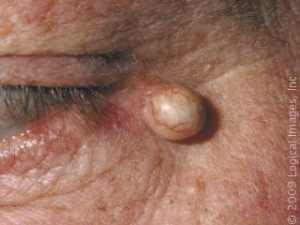
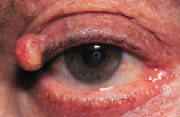
Picture 4 – Sebaceous Cysts Picture 5 – Epidermal Cyst
Source – skinsight Source – websightmd
Sebaceous Cyst Removal
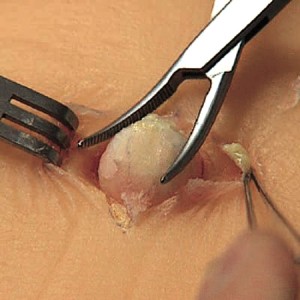
Picture 6 – Sebaceous Cyst Removal
Source – limbsandthings
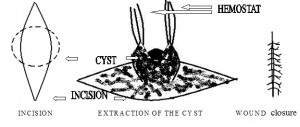
Picture 7 – Sebaceous Cyst Removal Picture
Source – surgicalpal
If you notice growths on your skin that look like Sebaceous Cysts, you should consult your healthcare provider. Sebaceous Cysts are not dangerous but leaving an infected cyst untreated for long can lead to serious complications. So it is important that a medical expert makes sure that you do not have a complicated Sebaceous Cyst.
References:
http://en.wikipedia.org/wiki/Epidermoid_cyst
http://womenshealth.about.com/cs/dermatology/a/sebaceouscyst.htm
http://www.nlm.nih.gov/medlineplus/ency/article/000842.htm
http://www.wrongdiagnosis.com/s/sebaceous_cyst/treatments.htm

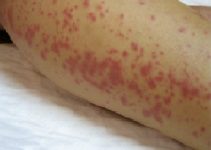
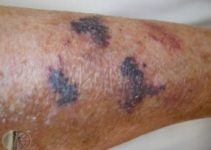
After a lot of research i can say. Without a doubt that: This is what i have in my balls!
The left side of my scrotum, i mean. Yep i am very sure! this is what it is!
Of to the doctor to see what’s up… and yeah… things to look forward to, huh?
Thank you so much for the info, very helpful and appreciated!
Sebaceous cyst isn’t much harmful but people concern it a lot due to cosmetic reasons.
Where can I find private clinics in Kuala Lumpur, Malaysia for surgical removal of a vast amount of cysts.